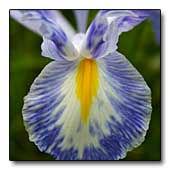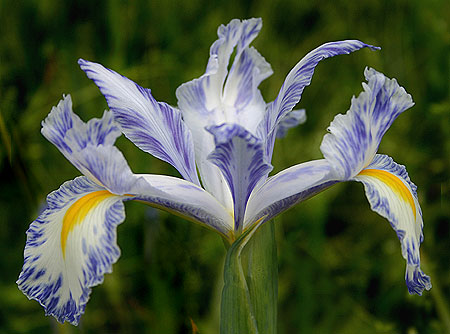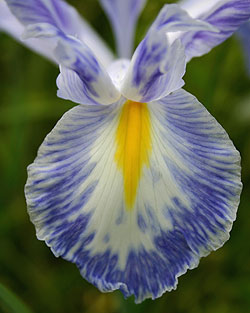Iris xiphium 'Delft Blue'
DUTCH IRIS
Family: Iridaceae
Pronounced: EYE-riss ZIH-fee-um

Quick Jumps
Growing Guide
Rainy Side Notes
GROWING GUIDE

Geographic Origin:
Garden.
Plant Group:
Bulbs.
Hardiness:
Sunset zones: 2b-24.
USDA zones: 5-9.
Mature size:
Height: 4-6 inches (10-15 cm).
Flowering period:
May.
Flowering attributes:
White flowers with an irregular pattern of blue along the outside edges the petals, with the falls sporting a bright yellow blotch.
Leaf attributes:
Linear green leaves.
Light:
Full sun.
Soil:
Humus rich, moist, well-drained soil.
Feeding:
At planting time fertilize with a low nitrogen fertilizer.
Propagation Methods:
Divide bulbs when flower quality declines. Lift bulbs after foliage withers and separate out the offsets to replant.
Pests and Diseases:
Mosaic or stripe can be a problem causing mottling of the leaves.
Rainy Side Notes

Dutch irises are excellent as cut flowers. The plants are easy to cultivate and I consider the flowers a spring mainstay in my cutting garden.
In the fall, plant the bulbs three inches deep and four inches apart, deeper in sandy soil. In spring, the bulbs can be succession planted to stretch the cut flower season. Keep bulbs dry during the summer season, an easy task considering our Mediterranean style climate that gives us dry summers.
Dutch iris makes an excellent spring container plant. Pot up bulbs in autumn and stage the container in spring when the iris comes into bloom. When flowers finish blooming, whisk the pot away to a hidden spot to allow the foliage to ripen. Plant the bulbs out in the garden the following fall.
Selected Plant of the Week for September 26, 2011.
Photographed in author's garden.
A Pacific Northwest Plant of the Week (2011)

Gardening for the Homebrewer: Grow and Process Plants for Making Beer, Wine, Gruit, Cider, Perry, and More
By co-authors Debbie Teashon (Rainy Side Gardeners) and Wendy Tweton
Copyright Notice | Home | Search | Bulbs

